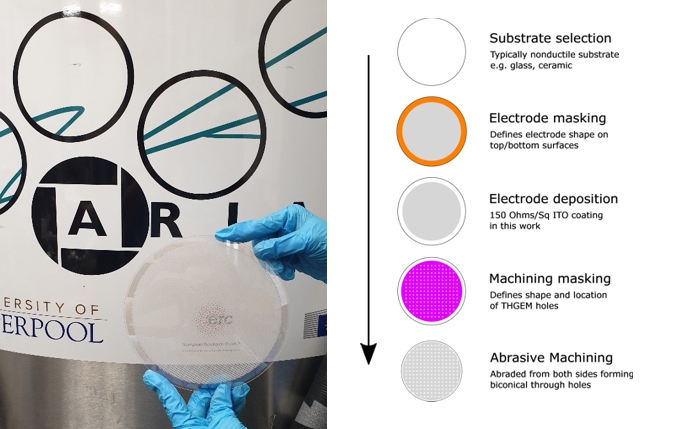A Novel Manufacturing Process for Glass THGEMs

The ARIADNE group has innovated a novel manufacturing process for glass THGEMs overcoming many limitations of the current state-of-the-art, providing a versatile device for a wide range of applications including in medical imaging, biotechnology, material analysis, radiation therapy dosimetry, radiation detection monitoring and astrophysics.
Thick Gaseous Electron Multipliers (THGEMs) are a type of gaseous ionization detector developed at CERN. The effectiveness of THGEMs has resulted in their widespread use within the contemporary field of TPC technologies, where TPCs are now integral within the neutrino and dark matter sectors.
Despite the many attractive features of THGEMs, there are limitations in terms of their design and manufacture such as sagging at larger scales, thickness non-uniformity, susceptibility to carbonisation due to discharges, variability in hole sizes and non-radiopurity.
| ARIADNE, being developed and constructed in the Liverpool LAr Facility, is a 1-ton two-phase liquid argon (LAr) time projection chamber (TCP) featuring a novel optical readout method. Images of particle tracks are taken from the secondary scintillation light with cameras. The technology has the potential to be an alternative to current charge readout methods for future LArTPC neutrino detectors. Initial characterisation studies are planned with cosmic rays and a UV laser. ARIADNE will then be placed in a charged particle beam at CERN for further characterisation studies, including development of 3D track reconstruction. |
|---|
The new glass THGEMs developed at Liverpool address all of the above challenges by allowing the creation of a GEM out of any type of glass material or non-ductile substrate. Our new masked abrasive machining process allows for unprecedented customisation of glass THGEMs. Importantly this is a very scalable technology which the ARIADNE team is already scaling up to a 53 x 53 cm x 1mm glass GEM for operation within the ARIADNE detector and for operation at the CERN Neutrino platform in the New Year for the imaging of a 2 x 2 m large-scale Neutrino detector prototype.
This innovation has been supported by the ERC ARIADNE starting grant and STFC IAA funding, and has been brought to fruition by the talented and strong ARIADNE team led by Dr Kostas Mavrokoridis.
The manufacturing process is now patent pending, and more information can be found in their recent publication (authors listed in alphabetical order):
A. Lowe, K. Majumdar, K. Mavrokoridis, B. Philippou, A. Roberts, C. Touramanis, A Novel Manufacturing Process for Glass THGEMs and First Characterisation in an Optical Gaseous Argon TPC, Applied Sciences. 2021; 11(20):9450.
https://doi.org/10.3390/app11209450
LIV.DAT student and ARIADNE team member Adam Lowe is working on hardware at the Liverpool physics department. His project titled Development of Liquid Argon TPC read-out technology for neutrino physics within the ARIADNE project sits within the CDT’s Data Analysis Work Package and is focused on scaling up this novel neutrino detection technology for future large scale experiments such as DUNE.
Image:The new glass THGEMs developed at Liverpool (left). A visual representation of the novel, patent pending, abrasive machine technique for the production of G-THGEMs (right).